![]()

The plant is so named because of its root's resemblance to a matted bird's nest.
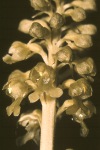
The rear of the flower forms a nectar bearing cup. Although flies are pollinators, it is believed that most flowers are self-pollinated and may even flower and set seed entirely underground. This, and its efficient vegetative propagation, can lead to quite dense stands of these plants.
Both shots were taken at a Buckinghamshire reserve at the beginning of June.
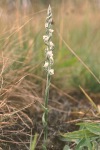
This orchid is not particularly common and its numbers are thought to be reducing due to habitat loss. However, the plant is known to be fairly resilient and there are examples of the re-appearance of flowers once grazing or mowing has ceased.
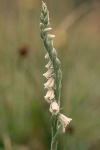
This close-up shows the single spiral of flowers well. The flowers are tiny and tube-shaped and are adapted for pollination by aphids.
Both shots were taken on at a Oxfordshire reserve at the beginning of August.
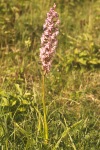
Like many orchids, it shows a preference for chalk and limestone but is also quite at home in damper, almost marshy conditions such as spring-line flushes.
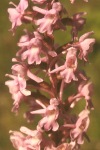
The flowers are usually pink but pure white ones (rather than albinos) are also relatively common.
Both these photographs were taken at a Buckinghamshire reserve in mid-June.

The flowers emit a perfume at night that attracts their primary pollinators - evening and night flying moths.

A reliable way of determining whether it is the Greater or Lesser species (if the habitat is insufficiently distinct) is to examine the attitude of the pollinia. This close-up shows the pollinia, the darker 'clubs' in the throat of the flower, in the characteristic inverted 'V' of the Greater Butterfly; in the Lesser species they are parallel.
Both shots taken in a Buckinghamshire reserve in early June.
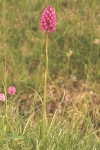
This orchid is widespread in dry chalk and limestone grassland in south and east England and can be found in sand dune slacks in the west of the country.
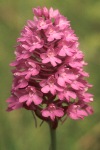
This close-up of a British specimen (taken at a Buckinghamshire reserve in mid-July) gives a better impression of the conical flower head that gives the flower its English name.
The plant is pollinated by a number of butterflies and moths and the flowers are adapted to the proboscises of such species - when the insect withdraws its proboscis the pollinia become attached and are subsequently transported to another flower.
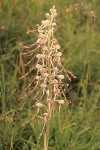
The flowers of the Lizard Orchid (Himantoglossum hircinum) are olive-grey and streaked with purple and they have an immensely long strap-like lip that often becomes entangled within the flower head. The flowers are claimed to smell of goats!
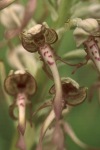
This close-up illustrates the long twisted 'tail' and the two leg-like side lobes of the labellum that gives the flower the fanciful resemblance to a lizard.

It is an uncommon plant of chalk and limestone grassland in south, east and central England.
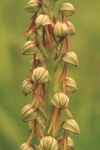
The flowers can be quite variable in colour from greenish, though yellow to dark red (even within the same plant - the close-up shows a marked darking of the lip towards the top of the plant). The flowers are also quite unusual in that they do not have a spur, instead the nectar is held in a hollow at the top of the lip.
Both shots were taken at a Kent reserve at the end of May.
Not represented: Bog, Fen, Frog, Coralroot, Small White, Dense-flowered, Lady's Slipper, Common Twayblade, Lesser Twayblade, Summer Ladies' Tresses, Irish Ladies' Tresses, Creeping Ladies' Tresses, Musk, Ghost and Lesser Butterfly Orchids.
![]()
Ó
Copyright Paul Nielsen 1997-2013